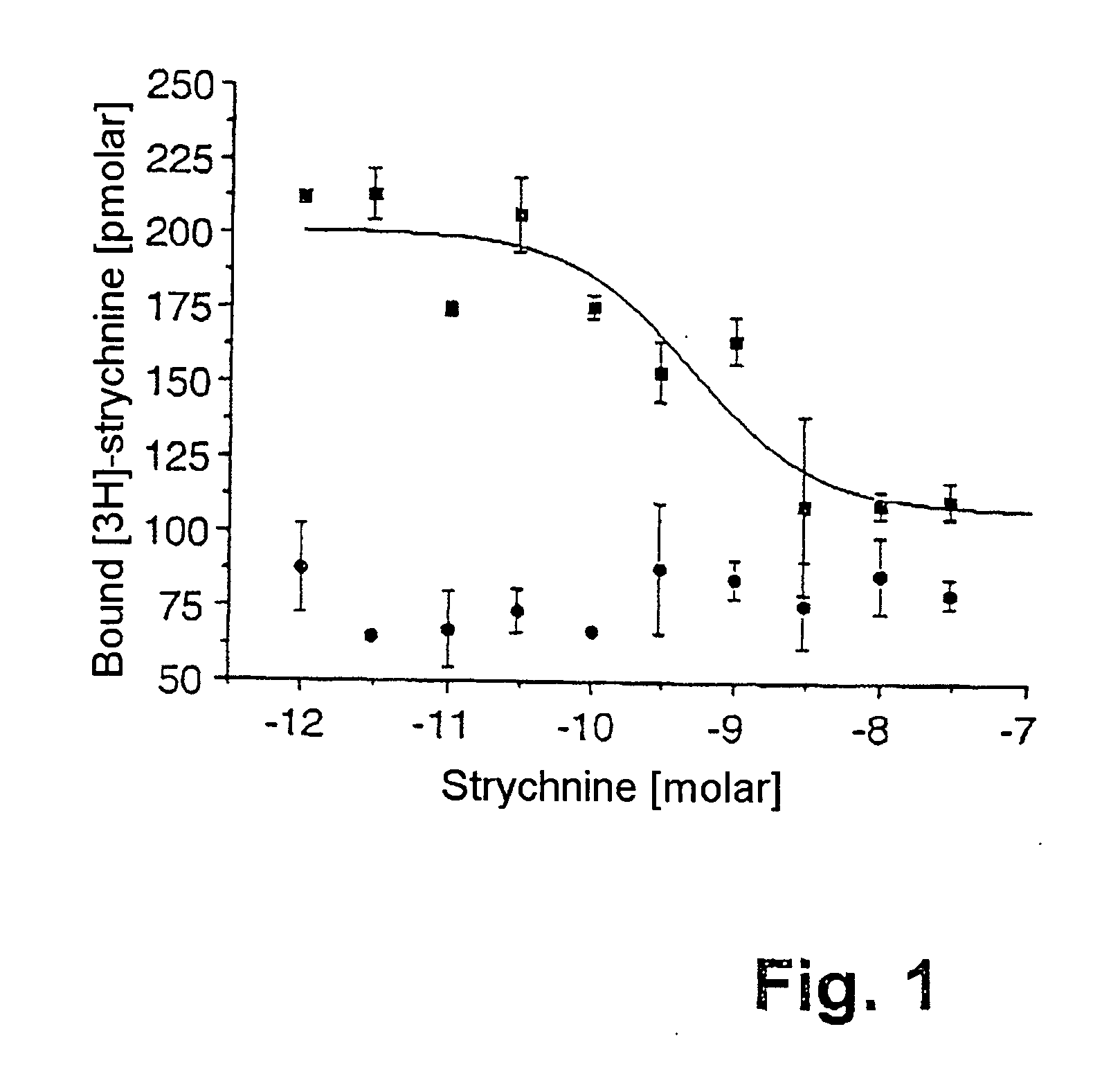Refolding of ion channel proteins
a technology refolding, which is applied in the field of refolding of ion channel proteins, can solve the problems of complicated method, induced familial hemiplegic migraine, and epileptic seizures in clinical cases
- Summary
- Abstract
- Description
- Claims
- Application Information
AI Technical Summary
Benefits of technology
Problems solved by technology
Method used
Image
Examples
example 1
Bacterial Expression of Ion Channel Protein
[0085] The plasmids pBS-Glyα1 and pRC / CMV-Glyα1, which were obtained from the Neurobiology Institute, Heidelberg University, were the starting material.
[0086] The gene for the human (homomeric) glycine α1-channel was amplified by PCR under standard conditions and with use of primers with attached restriction cleavage site and Pfu polymerase (Stratagene, USA) from the plasmid pRC / CMV-Glyα1, and ligated via the restriction cleavage sites into the expression vector pGEX2aHis (modified pGEX2a vector from Pharmacia, Sweden). The ligation mixture was transformed into TOP10F′ cells (Invitrogen, Karlsruhe, Germany). Positive colonies were identified and sequenced using the standard sequencing primers pGEX5′ for / pBAD rev. It was possible to identify a positive clone by comparison with sequences from the EMBL Genbank (ACC number X52009). For expression, the plasmid pGEX2aHis-Glyα1 was transformed into BL21 cells (Novagen, USA).
[0087] 200-400 ml of...
example 2
Method with Laurylsarcosine / FOS-C-14
a) Solubilization of the Ion Channel Protein with Laurylsarcosine
[0089] The bacteria obtained from example 1 are disrupted using a microfluidizer under standard conditions. This results in a mixture of bacterial protein and of ion channel protein in the form of inclusion bodies.
[0090] In parallel, a nickel-NTA-Superflow column (Qiagen) is packed with 8 to 15 ml of column material and equilibrated with 5 column volumes of washing buffer (PBS, 1% laurylsacosyl [first detergent], 10 mM β-MSH) at a migration rate of about 2 to 10 ml / min.
[0091] The protein-containing solution is cautiously loaded in a volume of 200-500 ml at a constant migration rate of about 2 ml / min. The flow-through is passed through the column a second time.
[0092] After loading of the protein material, the column is washed with 8-15 column volumes of washing buffer. The migration rate can be increased for this to 10-20 ml / min. The bacterially expressed ion channel protein is ...
example 3
Method with FOS-C-14 / Different Concentrations
[0102] The solubilization buffer used in this case for the ion channel protein α1Gly-R prepared in example 1 and present in inclusion bodies (IB) was the following buffer: PBS (phosphate-buffered saline), pH 7.4; 0.5% FOS-C-14; 10 mM DTT (dithiothreitol). About 50 ml of buffer were employed in each case for 10 ml of IB. Before addition of the solubilization buffer, the IB were once again thoroughly homogenized in a Potter. The IB were then slowly added dropwise to the buffer. In order to solubilize as many of the IB as possible, the cloudy solution was optionally left to stir in a cold room at 4° C. for one to two hours and, once or twice during this, to sonicate with the ultrasonic tip at cycle 5 / 50% for 3 min.
[0103] This suspension was subsequently centrifuged in a Ti-45 (Beckmann) in an ultracentrifuge at 40 000 rpm at 4° C. for 20 min. The supernatant was diluted with 1:10 with PBS in order to reduce the DTT concentration to 1 mM an...
PUM
| Property | Measurement | Unit |
|---|---|---|
| volume | aaaaa | aaaaa |
| volume | aaaaa | aaaaa |
| wavelengths | aaaaa | aaaaa |
Abstract
Description
Claims
Application Information
 Login to View More
Login to View More - R&D
- Intellectual Property
- Life Sciences
- Materials
- Tech Scout
- Unparalleled Data Quality
- Higher Quality Content
- 60% Fewer Hallucinations
Browse by: Latest US Patents, China's latest patents, Technical Efficacy Thesaurus, Application Domain, Technology Topic, Popular Technical Reports.
© 2025 PatSnap. All rights reserved.Legal|Privacy policy|Modern Slavery Act Transparency Statement|Sitemap|About US| Contact US: help@patsnap.com

